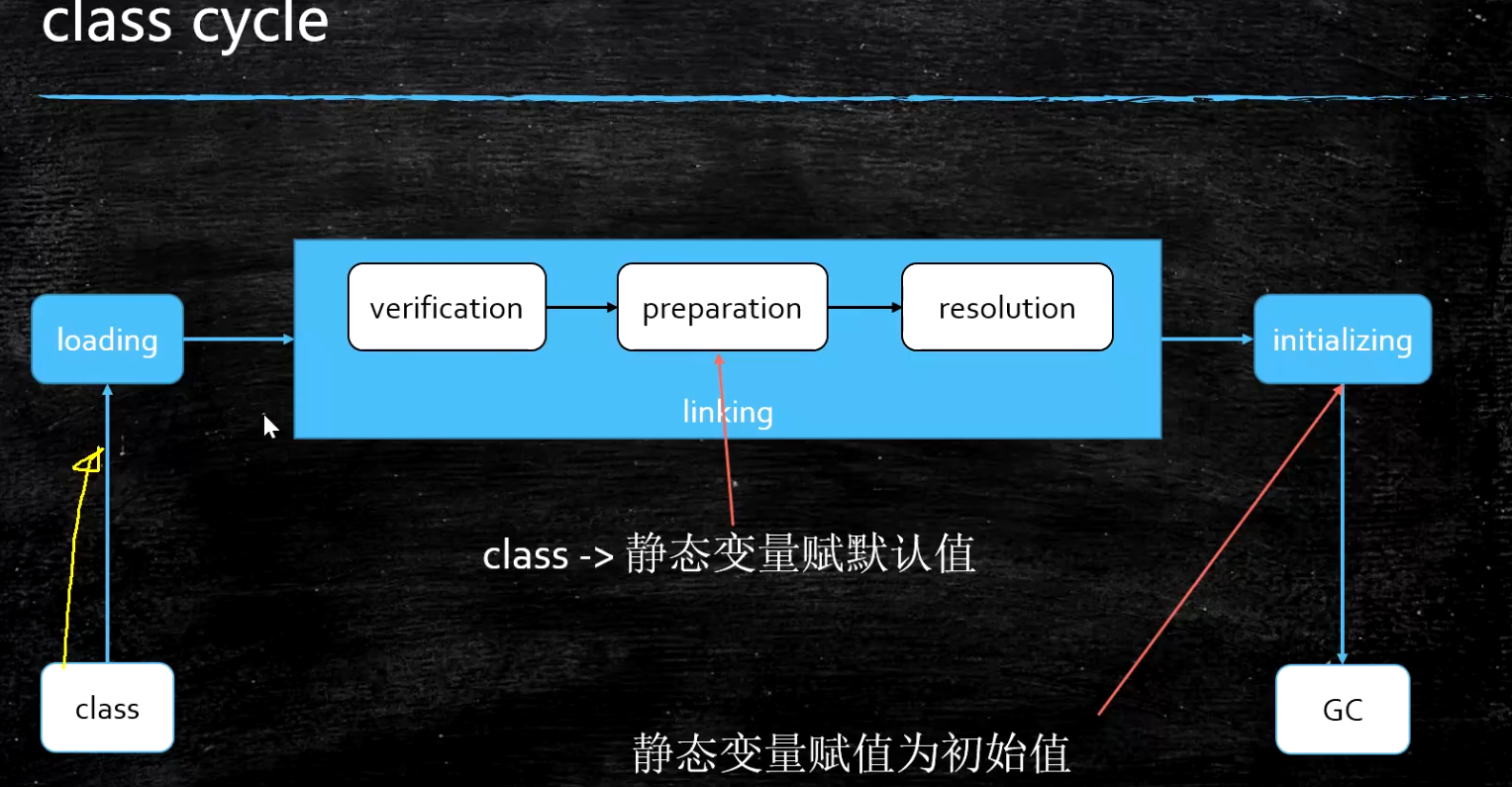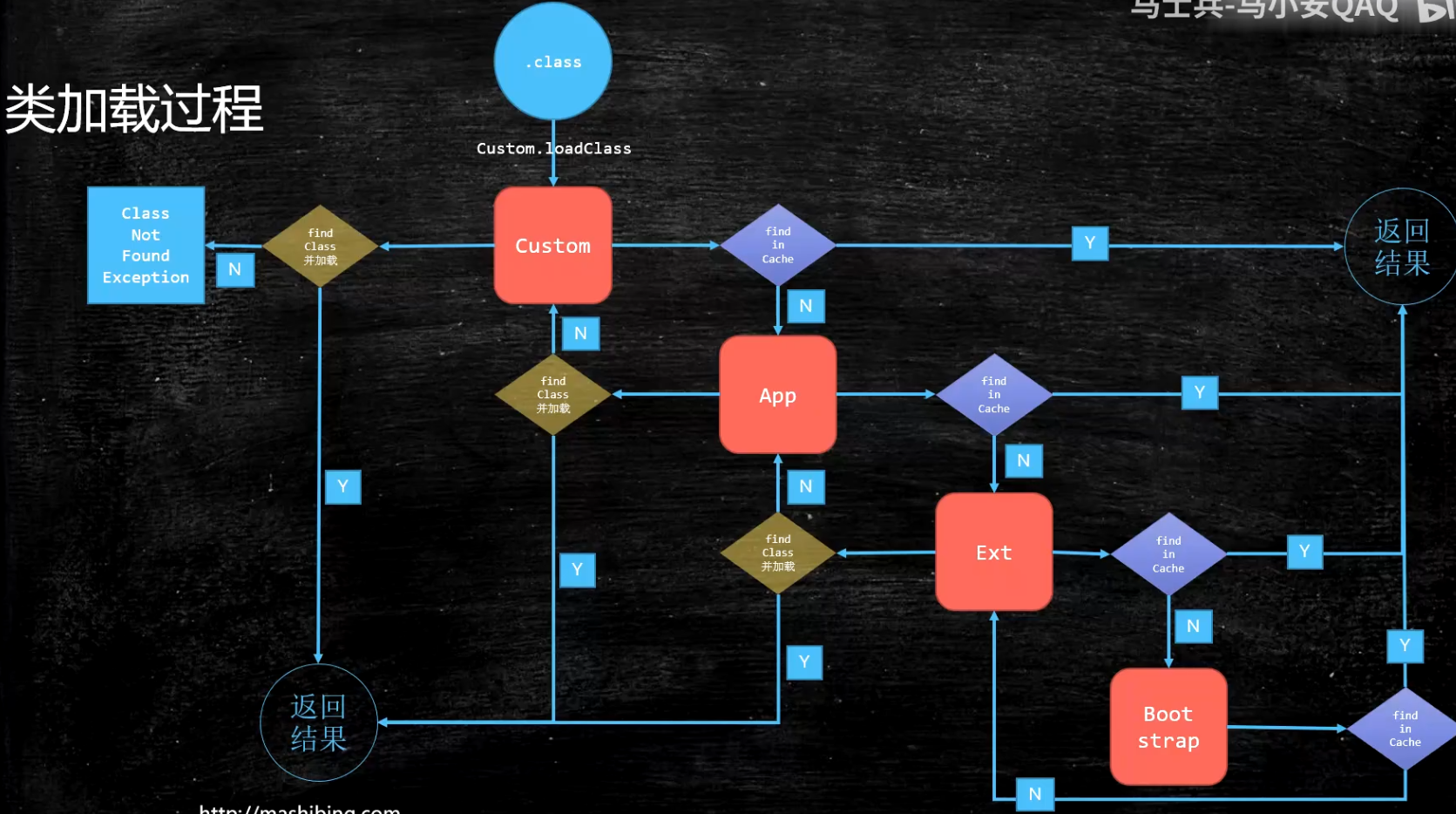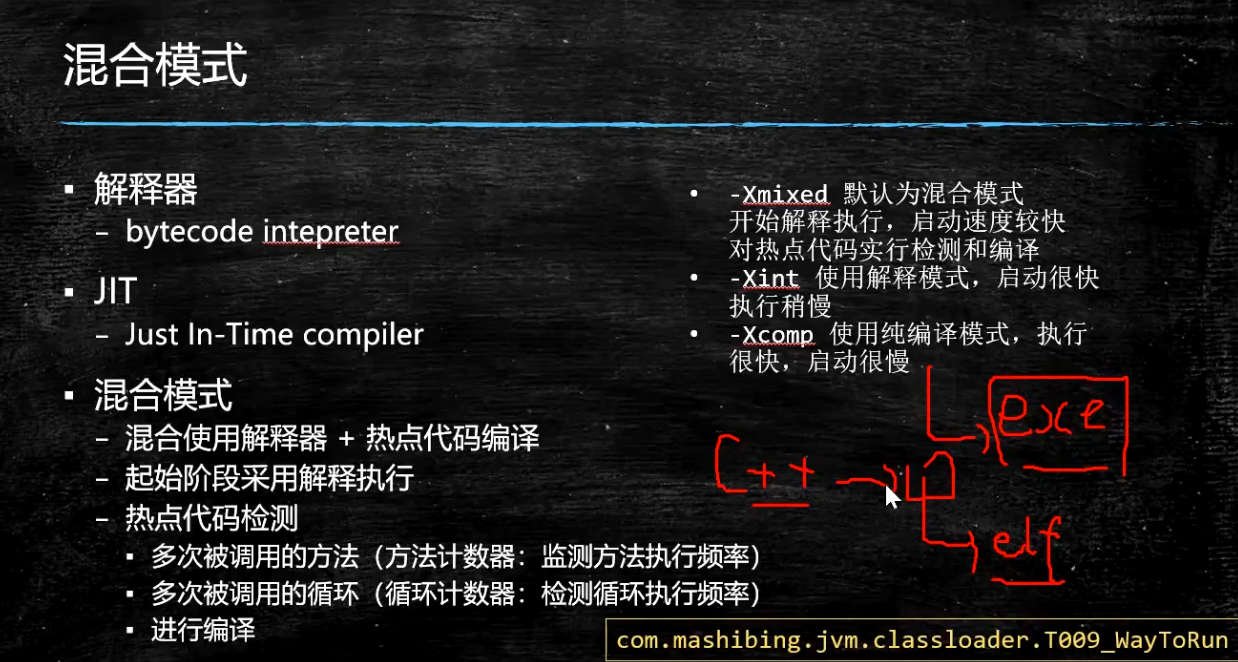JVM2-Class加载
类加载流程
class 是怎么从硬盘中加载到内存中:编译 加载 初始化

Loading
-
双亲委派,主要出于安全来考虑


package com.mashibing.jvm.c2_classloader; public class T004_ParentAndChild { public static void main(String[] args) { System.out.println(T004_ParentAndChild.class.getClassLoader()); System.out.println(T004_ParentAndChild.class.getClassLoader().getClass().getClassLoader()); System.out.println(T004_ParentAndChild.class.getClassLoader().getParent()); System.out.println(T004_ParentAndChild.class.getClassLoader().getParent().getParent()); //System.out.println(T004_ParentAndChild.class.getClassLoader().getParent().getParent().getParent()); } } -
LazyLoading 五种情况
-
–new getstatic putstatic invokestatic指令,访问final变量除外
–java.lang.reflect对类进行反射调用时
–初始化子类的时候,父类首先初始化
–虚拟机启动时,被执行的主类必须初始化
–动态语言支持java.lang.invoke.MethodHandle解析的结果为REF_getstatic REF_putstatic REF_invokestatic的方法句柄时,该类必须初始化
package com.mashibing.jvm.c2_classloader; public class T008_LazyLoading { //严格讲应该叫lazy initialzing,因为java虚拟机规范并没有严格规定什么时候必须loading,但严格规定了什么时候initialzing public static void main(String[] args) throws Exception { //P p; //X x = new X(); //System.out.println(P.i); //System.out.println(P.j); Class.forName("com.mashibing.jvm.c2_classloader.T008_LazyLoading$P"); } public static class P { final static int i = 8; static int j = 9; static { System.out.println("P"); } } public static class X extends P { static { System.out.println("X"); } } }
-
-
ClassLoader的源码
findInCache -> parent.loadClass -> findClass()
protected Class<?> loadClass(String name, boolean resolve) throws ClassNotFoundException { synchronized (getClassLoadingLock(name)) { // First, check if the class has already been loaded Class<?> c = findLoadedClass(name); if (c == null) { long t0 = System.nanoTime(); try { if (parent != null) { c = parent.loadClass(name, false); } else { c = findBootstrapClassOrNull(name); } } catch (ClassNotFoundException e) { // ClassNotFoundException thrown if class not found // from the non-null parent class loader } if (c == null) { // If still not found, then invoke findClass in order // to find the class. long t1 = System.nanoTime(); c = findClass(name); // this is the defining class loader; record the stats sun.misc.PerfCounter.getParentDelegationTime().addTime(t1 - t0); sun.misc.PerfCounter.getFindClassTime().addElapsedTimeFrom(t1); sun.misc.PerfCounter.getFindClasses().increment(); } } if (resolve) { resolveClass(c); } return c; } } -
自定义类加载器
- extends ClassLoader
- overwrite findClass() -> defineClass(byte[] -> Class clazz)
- 可以实现加密
- parent是如何指定的,打破双亲委派,学生问题桌面图片
- 用super(parent)指定
- 双亲委派的打破
- 如何打破:重写loadClass()
- 何时打破过?
- JDK1.2之前,自定义ClassLoader都必须重写loadClass()
- ThreadContextClassLoader可以实现基础类调用实现类代码,通过thread.setContextClassLoader指定
- 热启动,热部署
- osgi tomcat 都有自己的模块指定classloader(可以加载同一类库的不同版本)
package com.mashibing.jvm.c2_classloader;
import com.mashibing.jvm.Hello;
import java.io.ByteArrayOutputStream;
import java.io.File;
import java.io.FileInputStream;
import java.io.FileOutputStream;
public class T007_MSBClassLoaderWithEncription extends ClassLoader {
public static int seed = 0B10110110;
@Override
protected Class<?> findClass(String name) throws ClassNotFoundException {
File f = new File("c:/test/", name.replace('.', '/').concat(".msbclass"));
try {
FileInputStream fis = new FileInputStream(f);
ByteArrayOutputStream baos = new ByteArrayOutputStream();
int b = 0;
while ((b=fis.read()) !=0) {
baos.write(b ^ seed);
}
byte[] bytes = baos.toByteArray();
baos.close();
fis.close();//可以写的更加严谨
return defineClass(name, bytes, 0, bytes.length);
} catch (Exception e) {
e.printStackTrace();
}
return super.findClass(name); //throws ClassNotFoundException
}
public static void main(String[] args) throws Exception {
encFile("com.mashibing.jvm.hello");
ClassLoader l = new T007_MSBClassLoaderWithEncription();
Class clazz = l.loadClass("com.mashibing.jvm.Hello");
Hello h = (Hello)clazz.newInstance();
h.m();
System.out.println(l.getClass().getClassLoader());
System.out.println(l.getParent());
}
private static void encFile(String name) throws Exception {
File f = new File("c:/test/", name.replace('.', '/').concat(".class"));
FileInputStream fis = new FileInputStream(f);
FileOutputStream fos = new FileOutputStream(new File("c:/test/", name.replaceAll(".", "/").concat(".msbclass")));
int b = 0;
while((b = fis.read()) != -1) {
fos.write(b ^ seed);
}
fis.close();
fos.close();
}
}
-
混合执行 编译执行 解释执行
-
检测热点代码:-XX:CompileThreshold = 10000

-
package com.mashibing.jvm.c2_classloader;
public class T009_WayToRun {
public static void main(String[] args) {
for(int i=0; i<10_0000; i++)
m();
long start = System.currentTimeMillis();
for(int i=0; i<10_0000; i++) {
m();
}
long end = System.currentTimeMillis();
System.out.println(end - start);
}
public static void m() {
for(long i=0; i<10_0000L; i++) {
long j = i%3;
}
}
}
//混合模式
2928
Process finished with exit code 0
//解释模式 使用-Xint
2928
Process finished with exit code 0
Linking
- Verification
- 验证文件是否符合JVM规定
- Preparation
- 静态成员变量赋默认值
- Resolution
- 将类、方法、属性等符号引用解析为直接引用
常量池中的各种符号引用解析为指针、偏移量等内存地址的直接引用
- 将类、方法、属性等符号引用解析为直接引用
Initializing
调用类初始化代码
package com.mashibing.jvm.c2_classloader;
public class T001_ClassLoadingProcedure {
public static void main(String[] args) {
System.out.println(T.count);
}
}
class T {
public static T t = new T(); // null
public static int count = 2; //0
//private int m = 8;
private T() {
count ++;
//System.out.println("--" + count);
}
}
输出结果为2. 如果交换10 11行,输出结果为3
本文来自博客园,作者:gary2048,转载请注明原文链接:https://www.cnblogs.com/zhoum/p/15144000.html
本文版权归作者和博客园共有,欢迎转载,但未经作者同意必须保留此段声明,且在文章页面明显位置给出原文连接,否则保留追究法律责任的权利。


